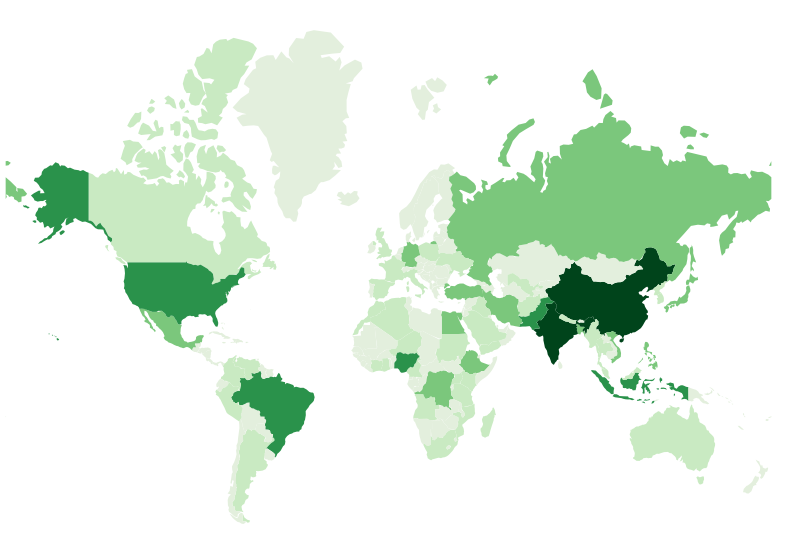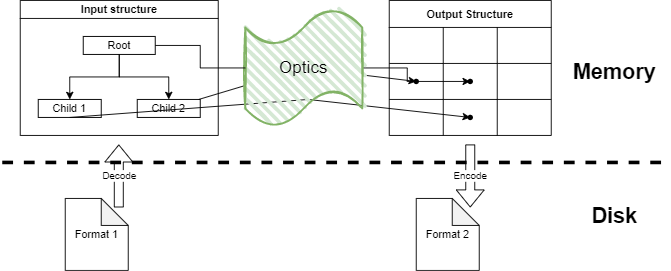ETL The Haskell Way
Posted on March 27, 2022Extract Transform Load (ETL) is a broad term for processes that read a subset of data in one format, perform a more or less involved transformation and then store it in a (maybe) different format. Those processes can of course be linked together to form larger data pipelines. As in many such general terms, this can mean very different things in terms of software architecture and implementations. For example, depending on the scale of the data the solution may range from unix shell pipeline to a full-blown Apache nifi solution.
One common theme is data impedance mismatch between formats. Take for example JSON and XML. They are surely different, but for any particular application you can find a way to move data from one to the other. They even have their own traversal systems (jq’s syntax and XPath).
The most widely used solution for small to medium data is to write small ad-hoc scripts. One can somewhat abstract over these formats by abusing jq.
In this blog post we will explore more elegant way to perform such transformations using Haskell. The purpose of this post is just to pique your curiosity with what’s possible in this area with Haskell. It is definitely not intended as a tutorial on optics, which are not for Haskell beginners, anyways…
The Problem
We will be enriching a geojson dataset containing countries at a world scale taken from natural earth and enriching it with population data in xml as provided by the world bank API so that it can be used, for example, to produce a choropleth map1 visualization.

Haskell is a curiously effective fit for this kind of problems due to the unlikely combination of three seemingly unrelated traits: its parsing libraries (driven by a community interested in programming languages theory), optics (also driven by PLT and a gruesome syntax for record accessors, at least up to the recent addition of RecordDotSyntax), and the convience for writing scripts with the stack tool (driven by the olden unreliability of cabal builds).
It is the fact that Haskell is so abstract, that makes it easy to combine libraries never intended to work together in the first place. Haskell libraries tend to define its interfaces in terms of very general terms (eg. structures that can be mapped into, structures that can be “summarized”, etc..).
Let’s break down how these work together.
Parsing Libraries
Haskell comes from a long tradition of programming language theory applications, and it shines for building parsers, so there is no shortage of libraries for reading the most common formats. But, more important than the availability of parsing libraries itself, it’s the parse, don’t validate approach in this libraries that works here: most of them have the ability to decode (deserialize,parse) its input into a well typed structured value in memory (think Abstract Syntax Tree).
So a typical workflow would be to read the data from disk into a more or less abstract representation in memory involving nested data structures, then transform it into another representation in memory (maybe generated from a template) through the use of optics and then serialize it back to disk:

Optics
Optics (lenses, prisms, traversals) are way to abstract getters and setters in a composable way. Their surface syntax reads like “pinpointing” or “bookmarking” into a deeply nested data structure (think XPath), which make it nice for visually keeping track of what is being read or altered.
The learning curve is wild, and their error messages convoluted, but the fact that in Haskell we can abstract accessors away from any particular data structure, and that there are well-defined functions to combine them can reduce the size of your data transformation toolbox. And lighter toolboxes are easier to carry around with you.
Scripting
A lot of the data wrangling programs are one-shot scripts, where you care about the result more than about the software itself. Having to create a new app each time can be tiresome, so using scripting and knowing you can rely on a set of curated libraries to get the job done is really nice. Starting with a script that can be turned at any time into a full blown app that works on all the major platforms is a plus.
The Solution
The steps follow the typical workflow quite closely, in our case:
- Parse the
.xmlfile into a data structure (a document) in memory. - Build a map from country codes to population.
- Read the geojson file with country info and get the array of features.
- For each feature, create a new key with the population.
This overall structure can be traced in our main function:
main = do
xml <- XML.readFile XML.def "population.xml" -- Parse the XML file into a memory document
let pop2020Map = Map.fromList $ runReader records xml -- Build a map Country -> Population
jsonBytes <- LB8.readFile "countries.geo.json" -- Parse the countries geojson into memory
let Just json = Json.decode jsonBytes :: Maybe Json.Value
let featureList = runReader (features pop2020Map) json :: [ Json.Value ] -- Get features with new population key
let newJson = json & key "features" .~ (Json.Array $ V.fromList featureList) -- Update the original Json
LB8.writeFile "countriesWithPopulation.geo.json" $ Json.encode newJson -- Write back to diskThe form of the input data is not especially well suited for this app. The world population xml is basically a table in disguise (remember the data impedance problem?). It is basically a list of:
<record>
<field name="Country or Area" key="ABW">Aruba</field>
<field name="Item" key="SP.POP.TOTL">Population, total</field>
<field name="Year">1960</field>
<field name="Value">54208</field>
</record>That means the function that reads it has to associate information from two siblings in the XML tree, but that is easy using the magnify function inside a Reader monad:
records :: Reader XML.Document [(T.Text, Scientific)]
records =
let
-- Lens to access an attribute from record to field. Intended to be composed.
field name = nodes . folded . _Element . named "field" . attributeIs "name" name
in do
-- Zoom and iterate all records
magnify (root . named "Root" ./ named "data" ./ named "record") $ do
record <- ask
let name = record ^? (field "Country or Area" . attr "key")
let year = record ^? (field "Year" . text)
let val = record ^? (field "Value" . text)
-- Returning a monoid instance (list) combines results.
return $ case (name, year, val) of
(Just key, Just "2020", Just val) -> [ (key, read $ T.unpack val) ]
_ -> []Note how lenses look almost like XPath expressions. The features function just takes the original features and appends a new key:
features :: Map.Map T.Text Scientific -> Reader Json.Value [ Json.Value ]
features popMap = do
magnify (key "features" . values) $ do
feature <- ask
let Just id = feature ^? (key "id" . _String) -- Gross, but effective
return $ case (Map.lookup id popMap) of
Just pop -> [ feature & key "properties" . _Object . at "pop2020" ?~ Json.Number pop ]
_ -> [ feature ]That is really all it takes to perform the transformation. Please take a look at the full listing in this gist. Even with the imports, it cannot get much shorter or expressive than this fifty something lines…
Revenge of the Nerds
So Haskell turns out to be the most practical, straightforward solution I found for this kind of problems. Who knew?
I would absolutely not recommend learning Haskell just to solve this kind of problems (although I would absolutely recommend learning it for many other reasons). This is one of the occasions in which learning something just for the sake of it pays off in unexpected ways.
No lengend! No arrow pointing north! Questionable projection! This is not a post on map making, just an image to ease the reader’s eye after too much text for the internet…↩︎